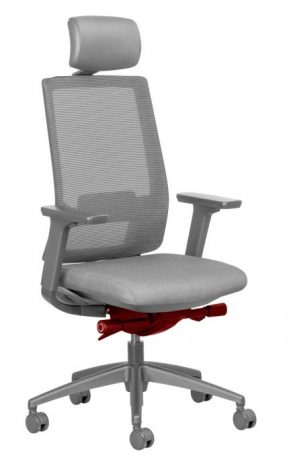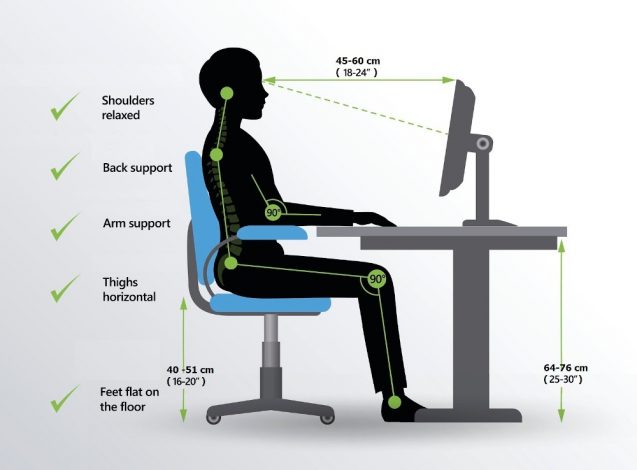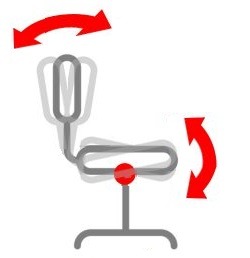- Your cart is empty
- Continue Shopping
What is an Ergonomic Chair?
According to Ergonomic Trends, “an Ergonomic Chair is one that not only follows best practices in terms of proven ergonomic
Located underneath the seat of an office chair is the chair swivel mechanism. This is a mechanical component that enables you to make specific adjustments to the seat and backrest of the chair, for example the seat height and angle of the backrest. The swivel mechanism allows you to personalise your seat position for optimal comfort and support. There are different types of swivel mechanisms available, but how do they work and what is the difference between them?

The swivel mechanism is the “heart” of a chair.
Selecting the right one can make all the difference for your long-term comfort.
Most types of chair swivel mechanisms have multiple adjustment levers and knobs which control the various movements, namely, seat height, backrest tilt, seat tilt, tilt tension, and seat depth.
Ergonomic chairs should allow both “static” and “dynamic” sitting. The correct static seated position is shown below:

The checklist for a correct static seating posture is where your:
Sitting statically in the above posture minimises the strain on your body. However, maintaining this posture for a long period is not possible. As you work, the continual inactivity, or static loading of your core muscles causes them to get tired, and so you begin to slouch in your chair.
For optimum comfort, you should be able to continuously alternate between a static and dynamic seated posture, and the swivel mechanism on your chair should facilitate this.
If it doesn’t, consider replacing your chair!
Dynamic sitting occurs in a chair that is fitted with a swivel mechanism that allows the backrest and seat to move relative to each other. This movement automatically stimulates, or activates various muscles in your lower back, core and legs. As a result, the blood-flow through these muscles increases, which prevents them from getting tired. Dynamic Sitting has long been acknowledged as the global benchmark for ergonomic comfort.
Both Synchro and Free-Float Swivel Mechanisms can be set to either STATIC or DYNAMIC sitting mode.
Synchro swivel mechanisms have a mechanical tilt that moves both the chair’s backrest and seat together in a fixed ratio. All synchro mechanisms ensure that the movement of the backrest is greater than the movement of the seat. Typically synchro swivel mechanisms have a 2:1 ratio i.e. the backrest moves 2 degrees for every 1 degree of movement in the seat.
In South Africa, ergonomic chairs are usually fitted with a synchro mechanism.
The seat and backrest can be locked into a number of static positions. If the mechanism is unlocked, it will be in a free-float position. In this position, the chair is dynamic and the backrest gives continual back support by moving with you.
A synchro swivel mechanism enables dynamic sitting and is therefore recommended for professional intensive use.
A Frontal Pivot or Knee-Tilt office chair mechanism has a pivot point that is closer to the front edge of the seat. This results in a wide-angle tilt that keeps the front of the seat relatively level. Unlike a normal synchronous swivel & tilt mechanism, the frontal pivot does not result in an increase in pressure on the underside of your thighs when the chair tilts backwards.
All Synchro swivel mechanisms have a mechanical tilt that moves both the chair’s backrest and seat together in a fixed ratio. All synchro swivel mechanisms ensure that the movement of the backrest is greater than the movement of the seat. Typically synchro swivel mechanisms have a 2:1 ratio i.e. the backrest moves 2 degrees for every 1 degree of movement in the seat.

A Free-Float or Multi-function swivel mechanism allows you to independently adjust the backrest and seat of the chair. This enables you to customise the exact angle of the seat and backrest to create your optimal sitting posture.
All orthopedic office chairs use a Free-Float swivel mechanism.
The seat angle can also be set at a negative tilt (forward sloping), to create an ‘open’ angle at the hips of approximately 100 degrees, resulting in the Perfect Ergonomic Office Setup. According to Occupational Safety and Health Administration (OSHA), a forward sloping seat helps increase blood flow to the lower extremities and at the same time reduces the pressure in the discs of the lower back. Why my back hurts when I sit?
In a static seating position you can lock the movement of both the seat and the backrest independently and in any position. In the free-float position, the chair is dynamic and the backrest provides continual back support by remaining in contact with your back and moving with you. Due to its highly advanced functionality, the free-float swivel mechanism is suitable for professional and intensive use.
A Free-Float swivel mechanism offers you the best orthopedic comfort.
Choosing the correct chair for your needs is critical for your long-term comfort and wellbeing at work. The type of swivel mechanism fitted to the chair plays a huge role in its overall comfort. A chair with a swivel mechanism that has a “good” or “excellent” Dynamic Rating is essential if you spend many hours sitting at your workstation.
According to Ergonomic Trends, “an Ergonomic Chair is one that not only follows best practices in terms of proven ergonomic
What is an orthopedic office chair and how does if differ from an ergonomic chair? Which is best for chronic lower back pain?
Office chairs have an array of levers and knobs to adjust the backrest, seat and armrests. How do you achieve a healthy sitting posture?